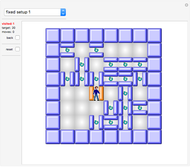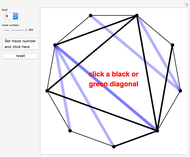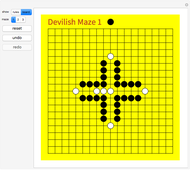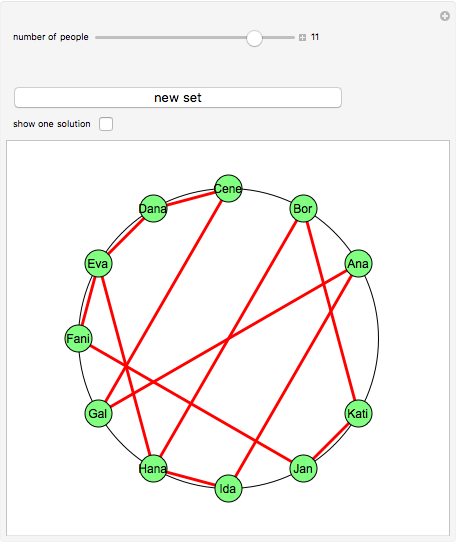One Disk Per Diagonal

Requires a Wolfram Notebook System
Interact on desktop, mobile and cloud with the free Wolfram Player or other Wolfram Language products.
Each diagonal parallel to the main diagonal (which is blank) is colored with one color. The objective is to have exactly one disk on each diagonal, which is equivalent to finding the adjacency matrix of a graceful graph.
[more]
Contributed by: Wai-Shun Cheung (December 2011)
Open content licensed under CC BY-NC-SA
Snapshots
Details
Graceful[n] generates a  -matrix with zero main diagonal and a unique 1 on each of its parallel diagonals. Essentially this is an adjacency matrix of an
-matrix with zero main diagonal and a unique 1 on each of its parallel diagonals. Essentially this is an adjacency matrix of an  -edge graceful graph, hence the name.
-edge graceful graph, hence the name.
Snapshot 1 (the rectangles are the 0's and the disks are the 1's): Once the "new game" button is hit, a new matrix  is generated. Then we apply a permutation matrix
is generated. Then we apply a permutation matrix  so that the resulting matrix
so that the resulting matrix  gives a puzzle to solve.
gives a puzzle to solve.
Snapshot 2: Click on a grid element to apply a transposition matrix; this is the effect of Swap[A,i,j]. In the snapshot, we click on position (3,5) or (5,3) to get  , where
, where  corresponds to the transposition (3,5).
corresponds to the transposition (3,5).
Snapshot 3: Continue the process to get back the "one disk per diagonal" structure. The answer is not unique.
Permanent Citation





















